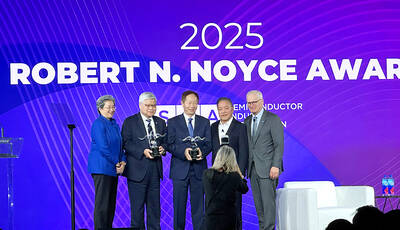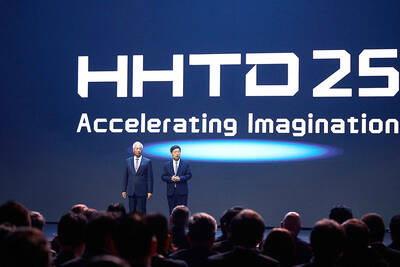In China’s smartphone market, Apple has seen better days.
Despite having reported record sales of the iPhone 5, Apple’s presence in China flagged last year. It was pushed out of the top five smartphone makers in that market in the third quarter, with just 8 percent of the market, according to the research company Canalys.
As Coolpad, Huawei (華為), Lenovo (聯想), Samsung and ZTE (中興通訊) surged ahead of Apple, an important force behind their success was MediaTek (聯發科), a Taiwanese chipmaker whose products have greatly reduced what it costs manufacturers to get new phones to market.
MediaTek entered the smartphone business late, introducing its first chipset in 2011 in a Lenovo phone, but within 18 months, it has taken 50 percent of China’s market for smartphone chips, analysts say.
That success has come with the adoption of what MediaTek calls a “turnkey solution.” Rather than simply provide a chip, the company also offers instructions for building a phone, the software architecture to run it and dedicated consultants to advise phone makers during the production process. MediaTek chief financial officer David Ku (顧大為) describes this as a franchise model in which all the clients must do is “turn on the burner.”
Peter Liao (廖哲宏), an analyst at Nomura Securities who covers the industry, said MediaTek saved phone makers the often prohibitive cost of research and development.
“It typically takes a lot of money and time to develop a new handset model, but MediaTek comes in and provides a total solution,” Liao said.
The company has proved wildly popular among Chinese phone makers. Besides supplying Huawei, Lenovo and ZTE, MediaTek also supports lesser-known manufacturers, including those that make “bandit phones” that imitate premium models from Apple, Samsung and HTC.
TCL Communication Technology Holdings (TCL通訊), a Chinese phone maker that sells phones primarily in Europe and Latin America, uses MediaTek’s chips. TCL chief operating officer Wang Jiyang said that when the company worked with MediaTek, its only important design tasks were to make the software easier to use and to tailor the look and feel of the phone.
“In general, with MediaTek’s help, we’re able to achieve almost twice as fast time to market, compared to other solutions,” Wang said.
MediaTek was founded in 1997. It made chips for home entertainment electronics like DVD players and televisions before moving into components for CD and DVD-ROM devices. In 2004, it began making chips for small mobile phones.
MediaTek estimated that it ranked at the top of the Chinese market last year with sales of 110 million smartphone chips, up from 10 million chips the previous year.
By comparison, Qualcomm, the global leader in smartphone chips, was expected to finish in second place in China with 82 million chips shipped, according to the research firm DigiTimes.
MediaTek has been powered by consumers like Zhang Ying, 31, who want to try the latest technology, but not pay a premium for it. Zhang of Shanghai bought a knockoff HTC (宏達電) phone last year.
“Every person has a price point,” he said. “At a time when some of my friends were buying Samsung or iPhone, I wanted to show that I can keep up with them. A lot of domestic phones are cheap and of fairly good quality.”
People who think like Zhang are dominating sales, especially among first-time smartphone buyers. In a September report, global consulting firm McKinsey estimated that 69 percent of all smartphones sold in China would cost less than 1,500 yuan, or about US$240, by the second half of this year.
And MediaTek is taking its business model to other emerging markets. Its products support features that are popular in developing countries, like noise-reducing speakers and slots for two SIM cards.
In India, local brands like Spice and Micromax are introducing lower-priced smartphone models using MediaTek parts. In Brazil, phones by Motorola Mobility and local brands like Gradiente and Multilaser will also contain MediaTek chips.
“The markets we target have 5.8 billion people, whereas the US and Europe have less than 1 billion,” Ku said. “I need to aim at a global market, not just developed countries.”
MediaTek also released a chip last year for building basic smartphones that work in regions without mobile data networks. Users of these phones rely on Wi-Fi connections to download multimedia. These phones can cost as little as US$50. Those chips now account for 40 percent of MediaTek’s smartphone chip sales.
Mark Hung, an analyst at the research firm Gartner, calls the networkless chip one of the “fastest-growing smartphone segments,” as many consumers are looking to switch from their simple mobile phones to basic, low-cost smartphones.
“This is a fairly new phenomenon, and, as you can expect, mostly in emerging markets, including China,” Hung said.
For now, Apple has signaled that it has no intention of competing on price. The iPhone 5, released in China on Dec. 14, cost 300 yuan more than the two previous models, the iPhone 4S and 4, on their release days. More than 2 million units of the iPhone 5 were sold in its first weekend.
By contrast, Coolpad, Huawei, Lenovo, Samsung and ZTE have released new phones with similar performance at a third of the iPhone 5’s price of 5,288 yuan, and sometimes less.
“We believe that emerging countries should also be able to enjoy the use of information technology with the same computing power,” MediaTek chairman Tsai Ming-kai (蔡明介) said.
As the world’s largest market for smartphones, China is quickly becoming a bellwether for the progress of sales wars globally. The Chinese experience may show that any leading market position can be fickle, and new brands can appear seemingly out of nowhere to capture significant shares of the market.
Apple remains No. 2 in smartphone shipments worldwide after Samsung, but its position could be threatened as the competition expands to more consumers and more price points.
“Emerging economies are getting stronger,” Tsai said. “The industry dynamic is always evolving. Anything can happen.”

Shiina Ito has had fewer Chinese customers at her Tokyo jewelry shop since Beijing issued a travel warning in the wake of a diplomatic spat, but she said she was not concerned. A souring of Tokyo-Beijing relations this month, following remarks by Japanese Prime Minister Sanae Takaichi about Taiwan, has fueled concerns about the impact on the ritzy boutiques, noodle joints and hotels where holidaymakers spend their cash. However, businesses in Tokyo largely shrugged off any anxiety. “Since there are fewer Chinese customers, it’s become a bit easier for Japanese shoppers to visit, so our sales haven’t really dropped,” Ito

The number of Taiwanese working in the US rose to a record high of 137,000 last year, driven largely by Taiwan Semiconductor Manufacturing Co’s (TSMC, 台積電) rapid overseas expansion, according to government data released yesterday. A total of 666,000 Taiwanese nationals were employed abroad last year, an increase of 45,000 from 2023 and the highest level since the COVID-19 pandemic, data from the Directorate-General of Budget, Accounting and Statistics (DGBAS) showed. Overseas employment had steadily increased between 2009 and 2019, peaking at 739,000, before plunging to 319,000 in 2021 amid US-China trade tensions, global supply chain shifts, reshoring by Taiwanese companies and

Taiwan Semiconductor Manufacturing Co (TSMC) Chairman C.C. Wei (魏哲家) and the company’s former chairman, Mark Liu (劉德音), both received the Robert N. Noyce Award -- the semiconductor industry’s highest honor -- in San Jose, California, on Thursday (local time). Speaking at the award event, Liu, who retired last year, expressed gratitude to his wife, his dissertation advisor at the University of California, Berkeley, his supervisors at AT&T Bell Laboratories -- where he worked on optical fiber communication systems before joining TSMC, TSMC partners, and industry colleagues. Liu said that working alongside TSMC

TECHNOLOGY DAY: The Taiwanese firm is also setting up a joint venture with Alphabet Inc on robots and plans to establish a firm in Japan to produce Model A EVs Manufacturing giant Hon Hai Precision Industry Co (鴻海精密) yesterday announced a collaboration with ChatGPT developer OpenAI to build next-generation artificial intelligence (AI) infrastructure and strengthen its local supply chain in the US to accelerate the deployment of advanced AI systems. Building such an infrastructure in the US is crucial for strengthening local supply chains and supporting the US in maintaining its leading position in the AI domain, Hon Hai said in a statement. Through the collaboration, OpenAI would share its insights into emerging hardware needs in the AI industry with Hon Hai to support the company’s design and development work, as well